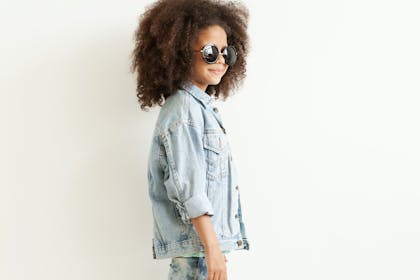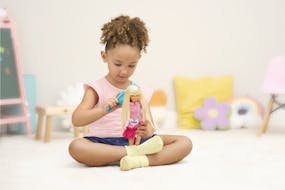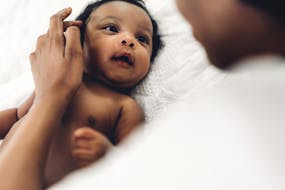We see mini supermodels everywhere: on billboards, in catalogues, in TV ads and on posters in our favourite shops. If you always find yourself thinking ‘my kids could do that’, then read our expert tips here before you sign your little one up.
This page contains affiliate links, which means we may earn a small amount of money if a reader clicks through and makes a purchase. All our articles and reviews are written independently by the Netmums editorial team.
For confident kids, modelling can be a great way of turning their love of dressing-up games into money to save for their future. Not only will they be able to earn money, but modelling can be a brilliant unique experience for kids – and it can be lots of fun too!
But before you rush to sign up your child, make sure you're fully clued up on the advice from the experts. Kelly Kalfa , a mum of two who runs the successful Kitsch Talent Agency (supplying child models for brands like Boden, John Lewis and Marks & Spencer) has the following word of warning:
'The thought of your child modelling can be extremely exciting, but always do your homework first and never rush into signing your child,' Kelly says.
'Beware of companies with hidden charges, or "guarantee" work, or offer "free" photo shoots then try to sell you a portfolio for hundreds of pounds.
'Trust your instincts as a mum!' she adds.
So if you are considering getting your son or daughter into child modelling, then read more of Kelly’s expert advice below, including the crucial questions you should ask, the checks you should always make, and exactly what to expect…
1 Be aware of the competition
As you might expect, child modelling is very competitive.
‘Every week my inbox is inundated with new applicants, but the offer of representation is based on more than just looks alone,’ says Kelly.
‘We only take on a handful of children into each category – based on age, ethnicity and location.’
If your little supermodel is one of the lucky ones to land an agent and then a booking, they will of course be paid for their efforts. However, fees vary depending on the age of your child, the work they do and the agency they are with.
‘As a guide, our clients pay from £60 an hour for photographic work for babies and toddlers to £80 an hour for 8-12 year olds – and TV commercials can pay more,’ says Kelly.
2 Check it's a reputable child modelling agency
Unfortunately, there are some untrustworthy companies out there, so make sure you take the time to ensure your child is being signed up to one of the many reputable child modelling agencies.
‘A good place to start is to get a recommendation from friends or colleagues who might already have a child with an agency,’ suggests Kelly.
‘Many of our kids are with us because their parents have contacted the PR department of High Street giants like M&S or John Lewis, who pass out a list of the agencies they use for their promotional material.’
You can also check out the Netmums Child Modelling Club thread for suggestions of modelling agencies and real-life experiences.
There are two types of agency that you need to know about: sole and non-sole.
A sole company means that your child can only be represented by that agency, while non-sole means they can be represented by more than one agency. So, have a think about which kind of agency would be the best fit for you and your child, which will help you decide which agencies you want to be looking at.
3 Ask about the costs involved
‘Make sure you understand the process of applying and the total cost of joining,’ warns Kelly.
‘Some agencies will say they don’t charge but then say you’ll need to have professional pictures taken that can cost well in to the hundreds.
‘Others may not charge upfront fees but will take a cut from your child’s first job on top of commission.
‘Ask which clients they work with and what percentage they take. On average, this is 25% but can vary enormously between agencies.’
It’s also very important to understand the agency payment terms.
‘When we receive a child’s money, we pay directly into the child’s building society or savings account, while some other agencies only pay out twice a year,' says Kelly.
4 Check the type of photographs you will need to supply
Of course, once you make contact with an agency you'll need to submit some photos of your little one. Initially, most agencies will only need a couple of colour snaps of your child.
‘If you have a decent camera on your phone, that will be fine – they don’t need to be professional photos,’ says Kelly.
‘Natural photos work best. Make sure they are recent, clear and in focus and that they show your child’s face and features clearly.
‘No other people or animals should be in the image, and no food, dummies, hats or large hair-bows – nothing that distracts from your child.
‘Always ask if there is a cost involved and how often you will need to update the photographs,' she explains.
How often you need to update your pictures will depend on your child's age, but this is a rough guide:
- Children aged 0 to 2 years should update every three months
- Children aged 2 to 4 years should update every six months
- Children 4 years and above should update once a year (unless there are any major changes)
You'll need a decent camera to take the initial pictures of your child. If you don't already have one, you can buy reasonably-priced digital cameras at Amazon. We like this model that sells for around £29.99.
Or why not upgrade your phone so you can take good photos with it? The Galaxy A40 by Samsung has a fabulous wide-angled camera and great battery life. Have a look on Amazon.
5 What to ask if your child gets a casting
After you've sent your photos in, the agency will contact you if your child gets a casting (which is like an audition).
‘Most castings are held after school or at weekends and are often fairly short notice,’ says Kelly.
‘The agency should give you all the information for the casting, including the date, time, place of the casting, and a summary of the job or role that your child is going for; also the sides (a script) if there are lines to be learnt and wardrobe requirements.
‘If your agent has the pay rate, production dates and location, they should also share these with you.’
Once you have been to the casting, you will hear back only if your child has been successful.
‘At this point most jobs put an ‘option’ or ‘pencil’ on your child. This means they are on the shortlist but do not definitely have the job.
‘From here they may be asked to attend a recall and/or asked to commence licensing.’
You don't have to dress your child specially for these castings, but just make sure that their hair has been washed beforehand at home and that they're wearing clean clothes.
For pampering, we like the Child's Farm range of baby and child toiletries as they cater for young, sensitive skin and even eczema sufferers. You can see the whole range here at Amazon.
6 What to ask if your child is booked for a shoot
The agency will let you know when your child has been ‘confirmed’. This means they've got the job!
All children up to the age of 16 must be licensed for every single job and, if school absence is needed, a letter of authorised absence will be required.
‘You will need to obtain authorised absence from your school in order for your child to take part in the shoot and for your agency to apply for a child performance licence from your local council,’ explains Kelly.
‘Once the council have received your child’s licence application and have made the necessary checks, assuming all is satisfactory, they will issue the licence and your child is then able to take part in the shoot.’
7 Keep in touch with your agency
‘A good agency should always be willing to answer your questions, queries and concerns,’ says Kelly.
But don’t panic if you don’t hear from your agency.
‘We’re all extremely busy and don’t have time to notify everyone individually of each and every submission. Your agent will normally only contact you if and when they have client interest.’
Most agencies are on social media, so it’s useful to follow and like their pages to stay in the loop with what they’re on the lookout for.
‘And don’t forget we need parents to do their bit too,’ adds Kelly.
‘You should always inform your agency of any unavailability, such as holidays and exams. And you’re also expected to update your child’s details (height, clothes and shoe size) on a regular basis.’
8 Make sure your child is enjoying it
As much as child modelling can be a fantastic experience, one of the most important things is that your child is happy doing it.
‘Being a mum in the industry, I know the most important thing is that your child (and you!) are having fun and enjoying the experience,’ says Kelly.
The Netmums Child Modelling Club is a great place to talk through experiences and excitement with other parents of child models, and there's lots of support available from fellow parents.
9 Manage the highs and lows
Whether it's excitement about being selected or disappointment about not making the final cut, it's important to help manage your child's expectations and safeguard their mental health.
We've also spoken to Netmums' official psychologist Linda Blair for her tips on coping with success and failure along the way.
‘If your child is modelling, then you need to be involved, too. That means going with them to shoots and castings,’ advises Linda.
‘That way, you’re there to support them, whatever the outcome.
‘If they’re not selected, you can reduce the sense of competition and talk about how it could be down to something arbitrary, like hair colour.
'That's also the chance to point out that everyone is beautiful in different ways, and those differing ways will suit different photo shoots.'
Remember that your child’s success needs to be handled with just as much care as any rejection.
‘If they are chosen, highlight what a privilege it is,’ says Linda.
‘And make sure you emphasise the qualities inside them, for example by praising their kindness or generosity. You can also draw their attention to attractive features in other children.’
10 In need of a jargon buster?
If you're new to the world of child modelling, all of the industry terms and phrases might feel overwhelming. Keep our jargon buster handy so you can be prepared for some of the language you might hear.
Casting – This is when your child has been picked by the client and they wish to meet them. Normally you will be asked to fill out a form with your child’s details and their agency's details. Then, your child will be invited into a room where they will take some shots or do some filming of them. This will usually take about five to 10 minutes, but on occasions you may have to wait around for a short time.
Optioned/Pencilled – This means your child has been shortlisted for a job.
Recall – When the client would like to see your child again, to decide from a shortlist who they would like to book for the job.
Wardrobe – This is when your child will go to be fitted for the clothes they will wear for the shoot.
Confirmed – This means that your child has definitely got the job.
Call time – This is the time that your child is expected to arrive at the job.
Basic shoot fee (BSF) – This is the rate at which your child will be paid. It can be for a day or per hour; rates vary depending on the client and most are dictated by them as well.
Buyout (BO) – This is the usage rights fee for your child if they are featured in the final cut of the commercial.
Looking for more tips on child modelling? Read our article below or chat to other parents in the forum.
Related stories
Everything you need to know about child modelling
CHAT: Should I take my four-year-old out of school for modelling?
35 celebrity kids who looks identical to their parents






